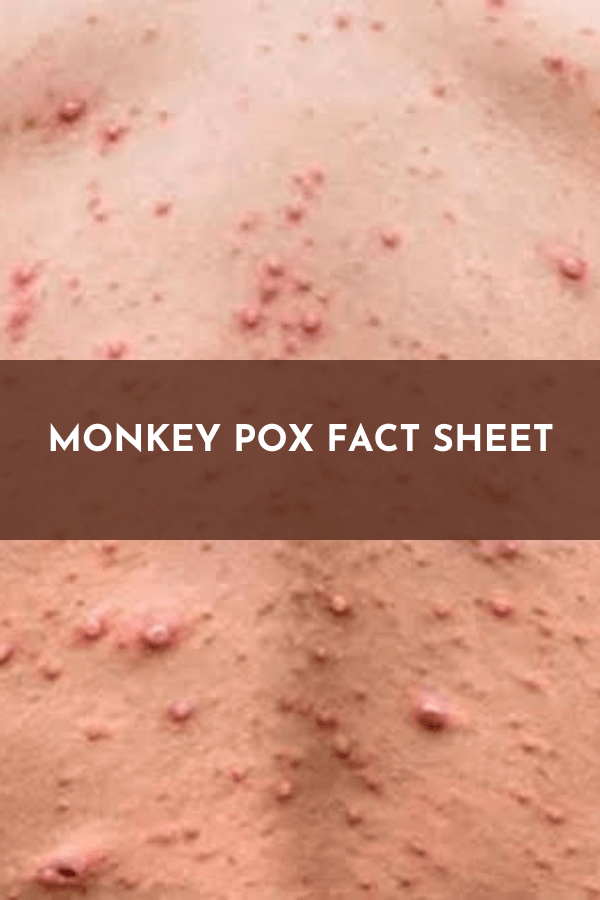Recently, several monkeypox outbreaks have been reported in multiple countries. Scientists are paying close attention to this virus, which could develop into a new pandemic.
Monkeypox, a relatively rare viral disease, has garnered attention due to its resemblance to smallpox.
While monkeypox is less severe, it’s essential to understand its characteristics, transmission, and implications.
In this comprehensive monkeypox fact sheet, we aim to provide you with a detailed overview of this intriguing disease, from its origins to prevention and control measures.
What is monkeypox (MPXV)?
Monkeypox is a viral disease that primarily affects humans and animals. It was first discovered in 1958 when outbreaks occurred among monkeys kept for research.
The virus is believed to be zoonotic, meaning it can be transmitted from animals to humans.
Monkeypox is primarily transmitted to humans through close contact with infected animals or their bodily fluids.
The virus has been found in various wild animals, including rodents and monkeys, which act as reservoir hosts.
Human-to-human transmission is possible, primarily through respiratory droplets or contact with infected skin lesions.
Monkeypox and smallpox share similarities, such as the appearance of skin lesions. However, monkeypox is generally less severe than smallpox.
Smallpox has been eradicated globally, while monkeypox continues to sporadically occur, mainly in Central and West African countries.
What is the cause of Monkeypox?

Monkeypox is caused by the Monkeypox virus, which belongs to the Orthopoxvirus group of viruses. There are 2 distinct strains of the virus, the Congo Basin strain, and the West African strain.
What are the symptoms or clinical features of Monkeypox?
Monkeypox begins with symptoms of fever, headache, muscle aches, backache, swollen lymph nodes, chills, and exhaustion, and may spread to other parts of the body.
It may also begin with a rash without any other symptoms, often starting on the face and then spreading to other parts of the body.
The rash progresses to pustules, which eventually crust over and fall off. Some people may only notice a few pimple-like lesions in the genital area or buttocks.
Symptoms usually appear 6–13 days after exposure, with a range of 5–21 days. While the fever occurs between 1-3 days.
The severity of monkeypox can vary from person to person. Some individuals experience mild illness with a limited rash, while others may have more extensive skin lesions and systemic symptoms.
In severe cases, complications such as pneumonia may occur, especially in individuals with weakened immune systems.
Most patients recover, but scarring and secondary bacterial infections of skin lesions are common.
How does monkeypox spread?
- Monkeypox is spread by direct skin-to-skin contact, breathing in droplets breathed out by a person with monkeypox during prolonged close contact, or contact with infected bodily fluids or contaminated objects, such as bedding or clothes.
- Sexual intercourse is also a means of spreading this virus; oral, vaginal, and anal.
- Also, hugging, kissing, cuddling, and massage can spread this virus.
Who is at risk of monkeypox? Monkeypox fact sheet
It literally can affect anyone but those affected in the current global outbreaks are gay, bisexual, or other men who have sex with men, anyone who has been in close contact with someone who has monkeypox can get the illness.
How is monkeypox prevented?
- Avoid contact with infected people, bedding, and towels.
- The smallpox vaccine can protect you from monkeypox, but it has side effects and is only recommended for known high-risk close contact with monkeypox cases.
- Use alcohol-based hand sanitizer to keep your hands sterile and wash your hands with soap water.
- Wear a mask when going close to an infected person
How is monkeypox diagnosed?
The diagnosis of monkeypox is challenging based solely on clinical symptoms because they resemble those of other diseases like chickenpox or even smallpox.
Laboratory testing is essential for confirmation. Laboratory tests for monkeypox include polymerase chain reaction (PCR) assays and serological testing.
PCR detects the virus’s genetic material in patient samples, while serological tests look for antibodies produced in response to the virus. Combining these tests helps confirm monkeypox infection.
How is monkeypox treated?
There is no specific antiviral treatment for monkeypox. Supportive care is the primary approach, which includes managing symptoms, providing hydration, and addressing complications if they arise.
Some patients may need simple pain medicines and oral fluids, while others may need supportive management.
Some special medications are available to help treat patients with severe illnesses.
Research into potential monkeypox treatments, including antiviral drugs and vaccines, is ongoing. Experimental therapies may be considered in severe cases, but their efficacy is not well-established.
Is there a vaccine for Monkeypox?
Yes. There are 2 vaccines against Monkeypox: ACAM2000 and JYNNEOS. These vaccines are used to prevent infection in a known exposed person.
What action should I take if I have been exposed to Monkeypox?
Self-isolate from others.
If you have been in contact with a case of monkeypox, you should monitor your health and check your temperature twice daily. If symptoms develop, contact your healthcare provider for further guidance.
What is the public health response?
Public health investigation, contact tracing, and control measures are initiated once a suspected case is reported to doctors, hospitals, and laboratories.
